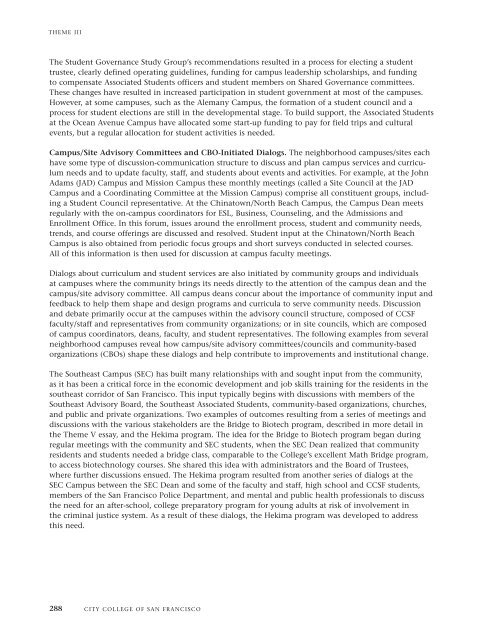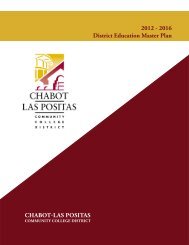City College of San Francisco - California Competes
City College of San Francisco - California Competes
City College of San Francisco - California Competes
You also want an ePaper? Increase the reach of your titles
YUMPU automatically turns print PDFs into web optimized ePapers that Google loves.
THEME III<br />
The Student Governance Study Group’s recommendations resulted in a process for electing a student<br />
trustee, clearly defined operating guidelines, funding for campus leadership scholarships, and funding<br />
to compensate Associated Students <strong>of</strong>ficers and student members on Shared Governance committees.<br />
These changes have resulted in increased participation in student government at most <strong>of</strong> the campuses.<br />
However, at some campuses, such as the Alemany Campus, the formation <strong>of</strong> a student council and a<br />
process for student elections are still in the developmental stage. To build support, the Associated Students<br />
at the Ocean Avenue Campus have allocated some start-up funding to pay for field trips and cultural<br />
events, but a regular allocation for student activities is needed.<br />
Campus/Site Advisory Committees and CBO-Initiated Dialogs. The neighborhood campuses/sites each<br />
have some type <strong>of</strong> discussion-communication structure to discuss and plan campus services and curriculum<br />
needs and to update faculty, staff, and students about events and activities. For example, at the John<br />
Adams (JAD) Campus and Mission Campus these monthly meetings (called a Site Council at the JAD<br />
Campus and a Coordinating Committee at the Mission Campus) comprise all constituent groups, including<br />
a Student Council representative. At the Chinatown/North Beach Campus, the Campus Dean meets<br />
regularly with the on-campus coordinators for ESL, Business, Counseling, and the Admissions and<br />
Enrollment Office. In this forum, issues around the enrollment process, student and community needs,<br />
trends, and course <strong>of</strong>ferings are discussed and resolved. Student input at the Chinatown/North Beach<br />
Campus is also obtained from periodic focus groups and short surveys conducted in selected courses.<br />
All <strong>of</strong> this information is then used for discussion at campus faculty meetings.<br />
Dialogs about curriculum and student services are also initiated by community groups and individuals<br />
at campuses where the community brings its needs directly to the attention <strong>of</strong> the campus dean and the<br />
campus/site advisory committee. All campus deans concur about the importance <strong>of</strong> community input and<br />
feedback to help them shape and design programs and curricula to serve community needs. Discussion<br />
and debate primarily occur at the campuses within the advisory council structure, composed <strong>of</strong> CCSF<br />
faculty/staff and representatives from community organizations; or in site councils, which are composed<br />
<strong>of</strong> campus coordinators, deans, faculty, and student representatives. The following examples from several<br />
neighborhood campuses reveal how campus/site advisory committees/councils and community-based<br />
organizations (CBOs) shape these dialogs and help contribute to improvements and institutional change.<br />
The Southeast Campus (SEC) has built many relationships with and sought input from the community,<br />
as it has been a critical force in the economic development and job skills training for the residents in the<br />
southeast corridor <strong>of</strong> <strong>San</strong> <strong>Francisco</strong>. This input typically begins with discussions with members <strong>of</strong> the<br />
Southeast Advisory Board, the Southeast Associated Students, community-based organizations, churches,<br />
and public and private organizations. Two examples <strong>of</strong> outcomes resulting from a series <strong>of</strong> meetings and<br />
discussions with the various stakeholders are the Bridge to Biotech program, described in more detail in<br />
the Theme V essay, and the Hekima program. The idea for the Bridge to Biotech program began during<br />
regular meetings with the community and SEC students, when the SEC Dean realized that community<br />
residents and students needed a bridge class, comparable to the <strong>College</strong>’s excellent Math Bridge program,<br />
to access biotechnology courses. She shared this idea with administrators and the Board <strong>of</strong> Trustees,<br />
where further discussions ensued. The Hekima program resulted from another series <strong>of</strong> dialogs at the<br />
SEC Campus between the SEC Dean and some <strong>of</strong> the faculty and staff, high school and CCSF students,<br />
members <strong>of</strong> the <strong>San</strong> <strong>Francisco</strong> Police Department, and mental and public health pr<strong>of</strong>essionals to discuss<br />
the need for an after-school, college preparatory program for young adults at risk <strong>of</strong> involvement in<br />
the criminal justice system. As a result <strong>of</strong> these dialogs, the Hekima program was developed to address<br />
this need.<br />
288 CITY COLLEGE OF SAN FRANCISCO







